The Cimitero Monumentale is more than just a cemetery. The sheer number of sculptures and monuments that were built for the tombs of Milan’s rich and famous has turned the cemetery into a quite impressive open-air museum.
Creation
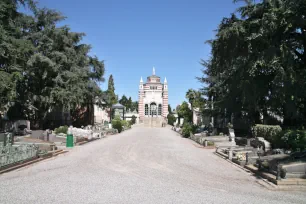
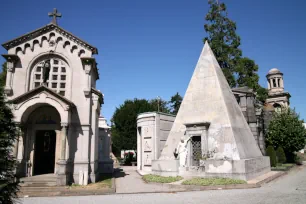
Shortly after the Italian independence in 1861 the idea was launched to consolidate the many small cemeteries in Milan, resulting in the creation of two large cemeteries: the Cimitero Monumentale for the wealthy and the Cimitero Maggiore for the ‘common’ people.
Between 1863 and 1866 the Cimitero Monumentale was laid out by the Italian architect Carlo Maciachini on an eighteen hectare large domain, later expanded to twenty-five hectares (62 acres).
A wide central lane lined with trees leads from the Famedio (hall of fame) along the Ossario (ossuary) to the Crematorio (crematory) at the other end. To the left and right are monumental tombs, often designed by famous sculptors and architects. The names on the tombs read like a who is who of Milan and include illustrious names such as Pirelli, Campari and Toscanini.
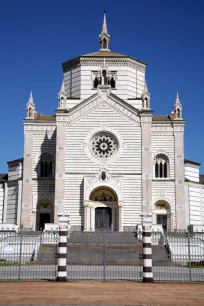
Famedio
The main building, with a 250 meter (820 ft) long black and white striped facade, dominates the entrance courtyard. The central domed structure is the Famedio, the hall of fame.
In this pantheon-like building you’ll find tombs of illustrious Milan citizens such as the Nobel Prize winner Salvatore Quasimodo, novelist Allessandro Manzoni and architect Luca Beltrami, who is best known for his renovation of the Sforzesco Castle.
Two small areas to the left and right of the Famedio are reserved for non-Catholics.

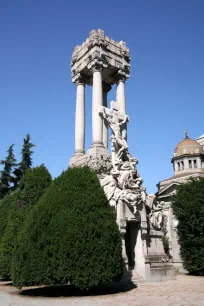
Highlights
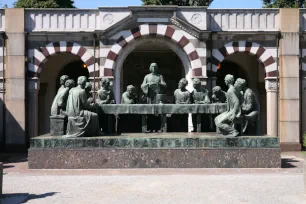
Milan’s wealthy families seemed to try and top each other by building large tombs, often decorated with plenty of sculptures of angels, putti, sphinx or other figures. All kind of architectural styles were used, from Egyptian, Neo-Roman and Byzantine over Neo-Gothic to more modern styles such as Art Nouveau, modernist and even post-modern.
The sheer number of different works of art by often highly acclaimed artists resulted in an interesting open air museum, where visitors are easily overwhelmed by the large number of monumental mausoleums and sculptures. Fortunately, placards installed on the grounds of the cemetery that show an overview of the most spectacular and most famous graves.
One notable monument is the family tomb of the Bocconi – who founded the Rinascente warehouse and Bocconi University – which supports an enormous marble baldachin decorated with statues of mourning women at the foot of a crucified Jesus.
The figure of Jesus is a recurring theme on the graveyard: the tomb of Campari is decorated with a sculpture group depicting Jesus and the apostles around a table during the Last Supper. The larger than life statues were created by Giannino Castiglioni, who also worked on the mausoleum for Antonio Bernocchi, an important local industrialist, for whom he created a marble spiraling band depicting the Way of the Cross.
Plenty of other important artists created works for the Cimitero Monumentale, including Giacomo Manzù, Medardo Rosso, Leonardo Bistolfi, Ernesto Bazzaro, Odoardo Tabacchi, Adolfo Wildt and Argentine artist Lucio Fontana.
- Next: Central Station
- More Sights & Attractions in Milan

